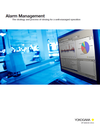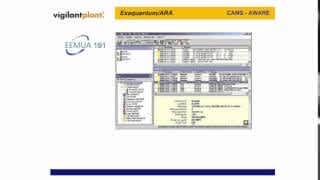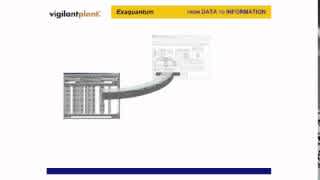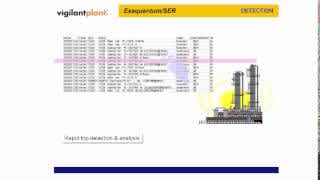The Problem
Plant operators are often faced with a high number of alarms and abnormal situations and are therefore unable to respond quickly enough to prevent safety related incidents, environmental issues, shutdowns and equipment damage. A poorly applied alarm management policy resulting in excessive alarms and events can also make operators routinely ignore alarms due to the excessive amount of information being received.
The Solution
Exaquantum/ARA is Yokogawa's Alarm Reporting and Analysis solution. Based on EEMUA 191 and ANSI/ISA-18.2-2009, the Exaquantum/ARA system assists supervisors and managers in implementing effective alarm management for process control by highlighting patterns in alarm and event occurrences, making it easier to identify and correct areas of concern.
Exaquantum Alarm Management in the Oil and Gas Industry
Oil and Gas Production, Oil and Gas Midstream, Refining and Petrochemicals, Chemicals, Pharmaceuticals, Power and Energy
Functionality: Comprehensive set of statistical reports and KPIs based upon ISA 18.2-2009 & EEMUA 191. ARA scheduling- Alarm and Events management can be aggregated by hour, day, shift, week, month, quarter and year providing alarm rates, counts, peaks, floods, etc.
Benefits: Reduction in the number of unwanted and distracting alarms allowing operators to react faster to abnormal situations with the proper corrective action, resulting in a safer and more productive plant; Improved plant safety, reduced environmental risk and enhanced maintenance response; Reduction in the amount of equipment damage; Reduced operator stress; Information available to key stakeholders on demand and by emails facilitating efficient and timely
Details
| Service Description | Yokogawa Deliverables |
|---|---|
| Event & Alarm Analysis | ✓ Report of current state of Alarm ✓ Statistics of Alarm & Events ✓ Statistics of manual interventions ✓ Top 5 Bad actors for Alarms |
| Alarm Philosophy | ✓ Alarm Philosophy document compliant with ISA 18.2 standards |
| Fundamental Nuisance Alarm Reduction | ✓ Report of the Nuisance alarms in the plant ✓ Root cause for the Nuisance alarms ✓ Countermeasures to prevent alarming for the Nuisance alarms ✓ Report containing the before and after improvements from this service |
| ISA 18.2/EEMUA#191 based Alarm System Design (Consultation & Training) |
✓ Report of the current Alarm state and the gaps in design compared to standards ✓ Support in the design of the new Alarm system as per standards ✓ Training on conducting Documentation & Rationalization exercise |
| ISA 18.2/EEMUA#191 based Alarm System Design (Software & Training) |
✓ Installation, commissioning and training of Exaquantum\AMD to establish Alarm Master design database |
| Operation State based Alarm Management (Consultation & Training) |
✓ Report of the current state of Alarm set points for various operation conditions in the plant ✓ Design of the new Dynamic Alarm Management |
| Operation State based Alarm Management (Software & Training) |
✓ Installation, Commissioning and training of AAASuite/Exapilot for Dynamic Alarm Management |
| Alarm Monitoring & Improvisation (Consultation) |
✓ Report of current state of Alarm ✓ Statistics of Alarm & Events ✓ Statistics of Manual Interventions ✓ Areas of improvisation based on current state of Alarms |
| Alarm Monitoring & Improvisation (Software & Training) |
✓ Installation, Commissioning and training of Exaquantum\ARA for Alarm monitoring and reporting |
- Reducing the number of distracting and nuisance alarms will allow operators to focus on and react faster to abnormal situations with the proper corrective action
- Reduced operator stress will improve reaction times for incident resolution
- Improved plant safety and reduced risk of serious environmental incidents
- Identification of improvement opportunities through focused KPIs
- Consolidated alarm and process information can be supplied in custom reports to provide additional analysis information
- Information available to key stakeholders on demand and by email, facilitating efficient and timely decision making
- 44 reports, many based on EEMUA 191 and ANSI/ISA-18.2-2009
- On demand access to Operator and Area KPIs
- Drill down from summary reports to the individual alarms and events
- Detailed filtering options to expose hidden problem areas
- Automatic replication of CENTUM plant hierarchy
- Reports can be scheduled for printing, storing and emailing
- Integration with Yokogawa's CENTUM DCS, CAMS for HIS and FAST/TOOLS SCADA
- Compatible with non-Yokogawa systems via OPC A&E 1.1
Exaquantum/ARA, hereafter referred to as 'ARA', continuously collects alarm and event data to provide statistical reports based on EEUMA 191 and ANSI/ISA-18.2-2009. These reports aid supervisors and managers in identifying which alarms and events are occurring most frequently and where the alarm management policy can be improved. Each report can be filtered and drilled down to desired levels, including individual alarm occurrences, and then exported to a number of file formats including PDF, Word and Excel.
ARA can be installed on a single server and provides access to multiple users via its intuitive web user interface, eliminating the need for any client software.
In addition to the web user interface, authorized access to the data is provided via Excel and SQL Server Report Builder, allowing custom reports to be created.
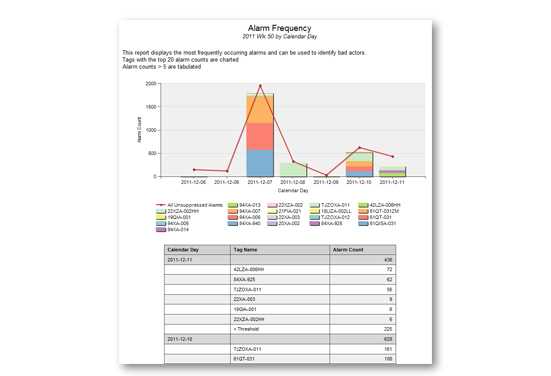
Alarm and Event Collection
Alarms and event data is continuously collected via OPC A&E 1.1. For those Yokogawa systems that use Exaopc, Yokogawa has extended Exaopc's OPC HDA server to include Historical Alarms & Events (HAE), which allows Exaopc to automatically buffer all alarms and events if the network connection to Exaquantum PIMS is lost. Once the connection is restored, all buffered Exaopc alarms and events will be available to be processed by ARA.
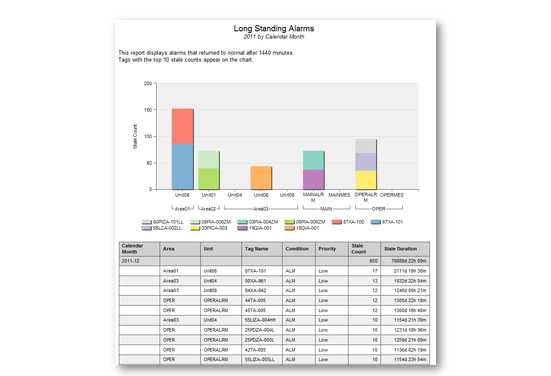
Interface with Yokogawa's 'CAMS for HIS'
ARA can retrieve the following information from Yokogawa's 'CAMS for HIS':
- Detection Disabled Alarms
This status is used in CAMS to annunciate important alarms and remove low-value alarm messages from DCS alarm displays within an operator station. Reports that are designed to reflect alarm loading from the operator's perspective exclude detection disabled alarms. Reports are provided that display information about the number and frequency of disabled alarms - Alarm Priority Overrides
CAMS provides alternative priority settings to override those present in the DCS. If present, ARA processes new alarms using the CAMS priority; otherwise the DCS alarm level is used - Group Suppressions
CAMS group suppression allows a group of alarms to be suppressed from the operator's perspective. Reports that contain alarm loading from the operator's perspective can be filtered to include or exclude group suppressed alarms - Shelved Alarms
CAMS allows operators to shelve alarms, temporarily removing them from the operator's view, allowing them to concentrate on more important alarms and return to the shelved alarms when convenient. Reports that relate to actions by operators can be filtered to include or exclude shelved alarms
Automatic Plant Hierarchy Creation
If configured in the Process Control System, ARA can extract and store plant hierarchy information contained within received alarm and event messages. This plant hierarchy can then be used to filter information displayed in reports.
Reports Overview
ARA provides 44 reports (described below), grouped into the following four areas:
- Management – providing a high-level overview of plant KPIs
- Performance – covering specific EEMUA 191 performance guidelines to quickly highlight potential areas of concern
- Operations – day-to-day operator reports covering alarm rates and trends
- Maintenance – highlighting problem alarms and aiding in the alarm rationalization process
Report Filters
ARA report filters are used to refine and analyze the report information to expose hidden alarming problems. As the information on the report is already generated, filtering occurs on demand. Depending on the report, the filters may include:
- Time resolution and periods to determine when problems are occurring and the alarming patterns
- Plant area or units to isolate areas of particular concern
- Operator selection to help identify the alarms and events that the selected operator sees most frequently
- Alarm tag and conditions help to identify patterns in a particular alarms behavior, enabling effective corrective action to be taken
- Alarm priority to highlight the priority distribution and discover alarms that may have an inappropriate priority level assigned to them
- Suppression types to view statistics on the number of alarms that have been disabled, group suppressed and shelved
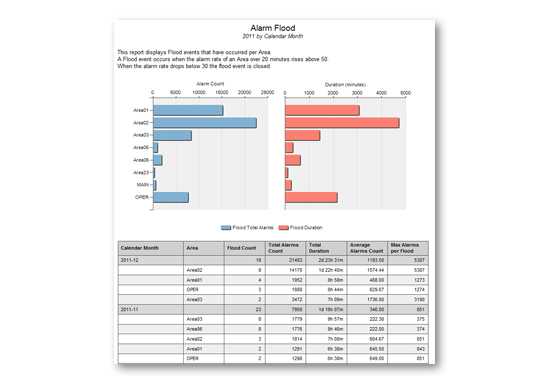
Report Scheduling and Exporting
Microsoft Reporting Services technology is used by ARA to schedule and distribute reports to various file locations and email addresses.
In addition, ARA provides key exporting options for ARA reports, such as:
- PDF – Standard for publishing, storing and distributing reports
- Excel – Allows further analysis and combining of disparate data for reporting
- Word – Creation of weekly/monthly reports that can be annotated and signed off
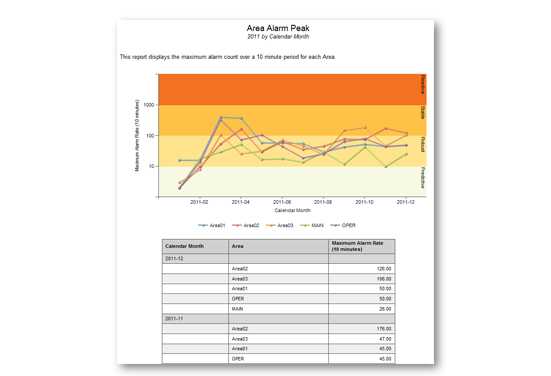
Web User Interface
Client access to ARA is provided via an intuitive web user interface, eliminating the need for specific client software. A central navigation bar provides links to each of the reports, localization options and other Exaquantum products.
The web user interface is compatible with Microsoft Internet Explorer versions 8, 9 and 10 with security provided through Windows local and domain user groups.
Localization
The ARA user interface can be seamlessly switched between installed languages. ARA is provided with US English by default with support for additional languages on request – please contact a local Yokogawa office for more information.
Exaquantum/ARA Report Branding
Report styles are stored centrally in ARA, allowing style changes to be made easily and consistently across all reports. This ensures that company standards can be adhered to in the production of reports.
Custom Reports
In addition to the reports supplied with ARA, custom reports can be created in:
- Excel – ARA data can be further analyzed and charted with process data from Exaquantum PIMS also incorporated to produce a single report containing both alarm and process data
- SQL Server Report Builder – Created in SQL Report Builder and accessed via the ARA web browser menu of reports, these reports can be scheduled and distributed

Alarm Rationalization using Exaquantum/ARA with Exaquantum/AMD (Alarm Master Database)
Alarm rationalization can be provided by using Exaquantum/ARA with Yokogawa's Master Alarm Database solution 'Exaquantum/AMD'.
Exaquantum/ARA provides a comprehensive set of reports in order to understand the performance of the system and to identify problem areas. Once such problem alarms have been identified, the alarm settings can then be modified using Exaquantum/AMD's comprehensive Management of Change (MOC) environment.
Resources
Alarm management is not just a project that has a start and end date; it's a continuous cycle. Once the alarm system has been reviewed and improvements have been identified, we must check that controls are in place to ensure the alarm system remains functional. The key is to ensure that the system is continuously monitored and any changes are fully documented. There are seven key steps for alarm management. Rationalization is one of those critical steps.
Downloads
Brochures
Videos
Exaquantum/ARA is a comprehensive set of statistical reports and KPIs based upon ISA 18.2-2009 & EEMUA 191. Alarm and Events can be aggregated by hour, day, shift, week, month, quarter and year providing alarm rates, counts, peaks, floods, etc. Exaquantum/ARA can be used to reduce the number of unwanted and distracting alarms allowing operators to react faster to abnormal situations with the proper corrective action, resulting in a safer and more productive plant, reduced environmental risk, enhanced maintenance response; Reduction in the amount of equipment damage. This package is part of our Alarm Management suite that utilizes software tools, alarm rationalization processes, and alarm philosophy generation as part of the solution aimed at reducing operator stress, operator overload prevention, and providing KPI information to key stakeholders on demand and by emails facilitating efficient and timely decision making.
Exaquantum is a comprehensive Plant Information Management System (PIMS) incorporating a data historian for real time and historical data, alarms, and events along with aggregations, role-based views and KPIs, graphical HMI, trends, reports, and integration with different systems. It provides a cetralized repository for users throughout the plant and is the foundation for most of Yokogawa's production, safety, and alarm optimization solutions and operator effectiveness solutions. Exaquantum can acquire data from all facets of a process and transform that data into easily usable, high-value actionable information that can be made avaialable across the enterprise.
Exaquantum/SER is a unified sequence of events recorder solution that provides a plantwide integrated view of alarms, events and associated process data. It identfies, collects, and processes alarms, events and process data related to plant trips from systems throughout the plant (DCS, historians, PIMS, PLCs, process automataion controllers, SCADA systems, safety systems, etc.) and stores the created information in an open and portable database. It can be used to provide trip detection based upon specific plant conditions and provide a full log of all relevant process information in the crucial period before and after a plant event. Exaquantum/SER's plantwide integrated view can be used for peformance analysis and in aiding investigation teams in performing root cause analysis and problem identification. This solution assists in the elimination or reduction in the number of unexpected incidents and trips while increasing availability and production.
Looking for more information on our people, technology and solutions?
Contact Us
